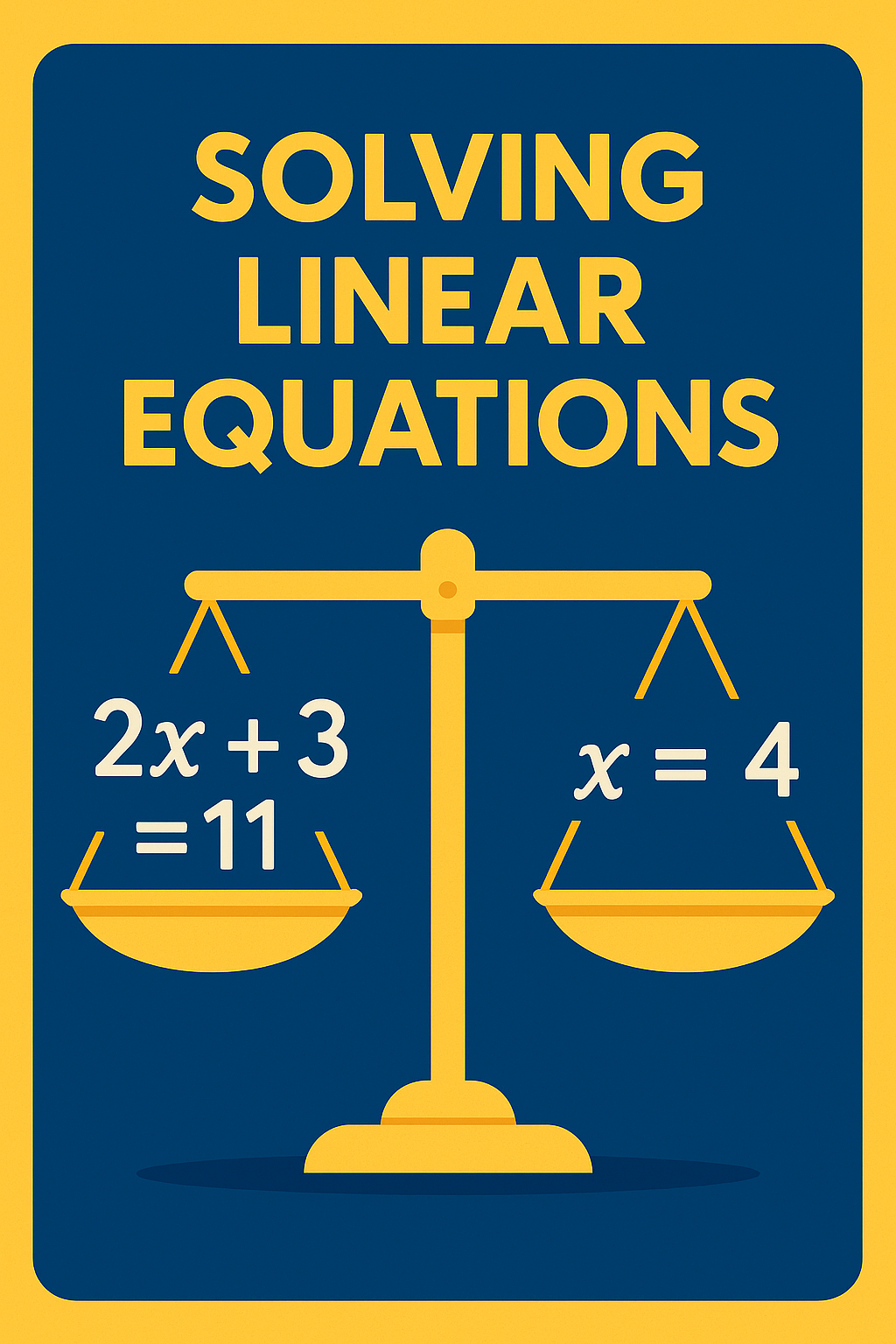Solving Linear Equations Quizzes

Visual overview of Solving Linear Equations.
Introduction
Solving linear equations means finding the value of the variable that makes the equation true. A linear equation has highest power 1 and appears everywhere in GCSE Maths and real life (costs, distances, scaling). Mastering the balance method and inverse operations lets you solve accurately and quickly.
Example: \(2x+5=13 \Rightarrow x=4\).
Core Concepts
What is a Linear Equation?
General form: \(ax+b=c\) with \(a\neq0\).
- \(x\) is the variable; \(a,b,c\) are constants.
- The graph is a straight line.
Solving Principles
- Isolate the variable on one side.
- Use inverse operations (undo + with −, × with ÷).
- Balance: whatever you do to one side, do to the other.
Inverse Operations
- Addition ↔ Subtraction
- Multiplication ↔ Division
Use them to move terms and isolate \(x\).
One-Step Equations
- \(x+5=12 \Rightarrow x=12-5=7\)
- \(3x=15 \Rightarrow x=15\div3=5\)
- \(x-4=9 \Rightarrow x=9+4=13\)
Two-Step Equations
- \(2x+3=11\) → subtract 3: \(2x=8\) → divide by 2: \(x=4\)
- \(5x-7=18\) → add 7: \(5x=25\) → divide by 5: \(x=5\)
Variables on Both Sides
Example
- \(3x+5=2x+9\)
- Subtract \(2x\): \(x+5=9\)
- Subtract 5: \(x=4\)
Equations with Brackets
Expand first, then solve.
- \(2(x+3)=14\) → \(2x+6=14\) → \(2x=8\) → \(x=4\)
Fractions and Decimals
Clear fractions/decimals early to reduce errors.
- \(\frac{x}{3}+2=5\) → subtract 2: \(\frac{x}{3}=3\) → ×3: \(x=9\)
- \(0.4x-1.2=2\) → ×10: \(4x-12=20\) → \(4x=32\) → \(x=8\)
Negative Signs
- \(-3x+7=1\) → \(-3x=-6\) → \(x=2\)
- \(-(2x-5)=9\) → \(-2x+5=9\) → \(-2x=4\) → \(x=-2\)
Special Outcomes: No Solution / Identity
- No solution: ends with a false statement (e.g. \(0=5\)). Example: \(2(x+1)=2x+5\) → \(2x+2=2x+5\) → \(2=5\) ❌
- Identity (infinitely many solutions): ends with a true statement (e.g. \(0=0\)). Example: \(3(x-2)=3x-6\) → true for all \(x\).
Checking Solutions
Substitute back into the original equation.
- For \(2x+3=11\) and \(x=4\): \(2(4)+3=11\) ✓
Word Problems
- “A number plus 7 is 15” → \(x+7=15\) → \(x=8\)
- “Twice a number minus 5 is 13” → \(2x-5=13\) → \(x=9\)
Worked Examples
Example 1 (Foundation): One step
\(x+6=12\) → \(x=6\)
Example 2 (Foundation): Multiply/Divide
\(4x=20\) → \(x=5\)
Example 3 (Higher): Two steps
\(3x+5=14\) → \(3x=9\) → \(x=3\)
Example 4 (Higher): Both sides
\(5x+3=2x+12\) → \(3x+3=12\) → \(3x=9\) → \(x=3\)
Example 5 (Higher): With brackets
\(2(x+4)=14\) → \(2x+8=14\) → \(2x=6\) → \(x=3\)
Example 6 (Higher): With fractions
\(\frac{x}{5}+3=7\) → \(\frac{x}{5}=4\) → \(x=20\)
Example 7 (Real life): Change statement
“A number minus 8 equals 15” → \(x-8=15\) → \(x=23\)
Example 8 (Real life): Money
“Twice a number plus 5 equals 17” → \(2x+5=17\) → \(x=6\)
Common Mistakes
- Not doing the same operation to both sides.
- Sign errors when moving terms or expanding brackets.
- Forgetting to divide by the coefficient of \(x\).
- Not clearing fractions/decimals early.
- Skipping the check step.
Applications
- Everyday problems (cost, distance, quantity).
- Algebra: solving for unknowns in formulas.
- Physics: linear relations for speed, time, or force.
- Finance: budgeting and simple interest models.
- Mathematical reasoning and modelling.
Strategies & Tips
- Draw a balance bar in your head: keep both sides equal.
- Expand brackets and collect like terms before isolating \(x\).
- Clear fractions/decimals at the start.
- Move the smaller \(x\)-term to reduce negatives.
- Always verify by substitution.
Summary / Call-to-Action
Linear equations are solved by careful balancing and inverse operations. Expand, collect, isolate, and check—these steps make even multi-step problems routine.
- Practise one-step and two-step problems to build speed.
- Drill equations with brackets, fractions, and both sides.
- Translate real-life statements into equations and solve.